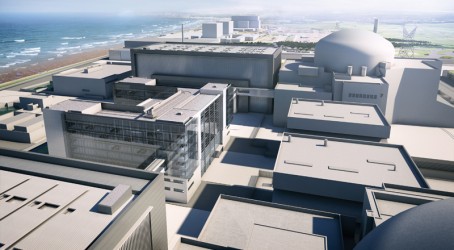A world of promise has dwindled to a window of opportunity. New nuclear power stations will be built on these shores but there will be fewer than one might have hoped and the going will be slower than originally anticipated. And consumers will pick up a substantial bill for the privilege. What a difference a few years make.
The notion of a resurgent nuclear industry in the UK was attractive to many. Unions – which had long argued that the building of a new nuclear fleet would attract investment, secure jobs, and help plug a looming energy gap – were pleased with the idea that the country’s nuclear skills base would be maintained.
Politicians, looking for further ways in which to decarbonise electricity generation, saw nuclear as a means, alongside renewables, of hitting binding targets to reduce emissions of carbon dioxide.
And the public were arguably swayed by a PR offensive on the part of the industry that aimed to overturn perceptions or misconceptions about nuclear power – although it did not convince a lot of people in Scotland.
Globally, countries that had never before developed civil nuclear power were keen to do so. Those that had previously invested in nuclear were keen to expand their fleets of power stations or to replace reactors that were shutting down. Reactor vendors Areva and Westinghouse were scheduled to build or were building new nuclear power stations in Europe, China and the US.
Fast forward to 2013, and the industry is inching towards the beginning of construction of a single EPR reactor at Hinkley Point C in Somerset. Last month, another regulatory hurdle was cleared as planning consent was granted to utility EDF to build the plant. But the biggest barrier to progress – the decision on what, if any, subsidy should be made available to the company – has yet to be decided.
Until that decision is made, some time in the coming months, nuclear new build is at an impasse. A positive decision on a subsidy, or “strike price,” will send a signal to other potential investors that the government means business.
But, once agreed, it is unlikely that a new reactor will be generating electricity at Hinkley Point before the early 2020s – later than an initial target of 2018. As for the development of other power stations, they seem even further down the track.
At the beginning of the generic design assessment (GDA), it is worth remembering, four reactor vendors were expressing an interest in having their designs approved for licensing in the UK. These were Areva of France, Westinghouse, Atomic Energy of Canada with the ACR-1000, and GE-Hitachi with the ESBWR.
But Atomic Energy of Canada and GE-Hitachi soon dropped out of the running. That left as the sole GDA participants the French company Areva, which is building its EPR design in Finland and Normandy, and Westinghouse, which is constructing its AP1000 design in China. Westinghouse has also signed contracts to build the first new nuclear reactors in the US for decades.
Westinghouse and Areva said at the time that they hoped the freeing-up of GDA resources would speed the approval of their respective designs. Yet the GDA was only completed for Areva’s EPR last December, after five years of studies. Site-specific approvals still have to be made at Hinkley Point C before construction can begin.
Westinghouse has not reached the end of the GDA, and is waiting for approval from a customer for its design before carrying out the final stages of the process. Such approval may be from NuGen, the consortium formed by GDF Suez and Iberdrola. NuGen’s Moorside project focuses on the development of a new generation of nuclear power stations with a total capacity of 3.6GW on land in west Cumbria.
The GDA became more tortuous than might otherwise have been the case thanks to the need to include a report from Mike Weightman, HM Chief Inspector of Nuclear Installations, on the implications of the Fukushima disaster in Japan. Weightman’s report was published in December 2011.
Although Weightman concluded that the desire to build new reactors in Britain should not be extinguished by events in Japan, the tsunami and subsequent nuclear accidents at Fukushima saw the tide swing against nuclear power in Germany.
This led to the withdrawal from the British scene of other utilities. RWE Npower and E.On turned their back on Horizon Nuclear Power, a joint venture they had established, which had been expected to deliver new power stations at Wylfa and Oldbury. Westinghouse, which had been banking on being chosen by Horizon as its preferred vendor, thus suffered a serious setback to its British ambitions.
The joint venture has subsequently been taken over by Hitachi, which intends to build its own Advanced Boiling Water Reactors (ABWRs) at the sites. But since Hitachi was not in the initial GDA process, it will have to enter the race from a standing start, and approval could take four years.


With EDF, which owns the former British Energy nuclear sites, strongly tied in with Areva, it was inevitable that the French companies would work together on delivery of a nuclear new build programme. But while no one could have foreseen the events of Fukushima, the government’s failure to tie-in a number of suppliers and utilities backing new nuclear looks remiss. It means that EDF/Areva, as the sole supplier to have completed the GDA and being ready to build, holds all the cards as the level of subsidy is negotiated. Presumably, Horizon will find itself in a similarly strong position in a few years’ time – dependent on Hitachi completing the GDA – when it looks for subsidies to build ABWRs at Wylfa and Oldbury.
Meanwhile, vacillation about nuclear power among politicians and a series of changes to energy policy have not helped, say proponents of the industry. Supporters of Nuclear Energy (SONE) has argued in the past that a strike price is unnecessary but now seems to reluctantly accept that a subsidy will be made.
Sir Bernard Ingham, the former press secretary to Lady Thatcher, is the group’s secretary. He said, in a statement to PE: “We do not know what the outcome of the ‘strike price’ negotiations between EDF and the government will be, or the cost. But what we do know is that the government, thanks partly to three successive ‘green’ energy secretaries, has got itself in a ludicrous position.
“I acknowledge that it was just plain bad luck that EDF became a monopoly supplier when Angela Merkel’s knee-jerk response to Fukushima in shutting down the German nuclear industry wrecked RWE/E.On’s finances. But the line laid down by Ed Miliband and enthusiastically adopted by Chris Huhne that there should be no public subsidy for nuclear power lies at the root of it.
“Ed Davey, the present energy secretary, refined that mantra into ‘no public subsidy for nuclear that is not also available to other low-carbon sources of electricity’ and compounded the problem.”
The Carbon Trust, among others, has subsequently backed subsidies for nuclear. The result of this, believes SONE, is that nuclear costs have been conflated with that of the subsidies granted to offshore wind. Ingham says the government could have offered to meet some of the high up-front costs of nuclear new build in the expectation that these would be paid back once the plants were generating electricity, negating the subsidy over time.
Roger Salomone, head of business environment policy at manufacturers’ organisation the EEF, says there “hasn’t been a clear policy on nuclear power until relatively recently”. He says it is policy reversals that have helped to ensure that we have not been this close to building a new power station for some years. Fukushima also slowed things down, he says.
“If you’re making investment in a plant that is going to last 60 years and investing billions of pounds up-front before you get a return, you want to be pretty sure what those returns are going to be over the years to cover the financing. There were two big hurdles to overcome for Hinkley Point C: one is planning, and the other is the issue of the strike price, for which negotiations are taking place.”
Sources close to the negotiations confirmed that EDF regarded it as the critical outstanding issue. “A clear stable policy is absolutely key if you want the utilities to come forward and make that investment,” Salomone says.
He adds that there is some hope that Hinkley Point C might be built more quickly than Areva’s EPRs in France and Finland, which have been subject to delays and escalating costs. This is because, he says, the design has been finalised under the GDA. “Bottoming-out all design issues before you start construction is a smart move,” Salomone says.
The hope is that UK suppliers and contractors will be involved no matter which reactor is being built. “Hitachi is making the right noises about that,” Salomone says.
The Areva EPR (European Pressurised Reactor) being built in Olkiluoto in Finland will be seven years late when operational and will have at least doubled in cost to €8 billion. The EPR plant being built in Flamanville, France is four years behind schedule. Its cost rose from an initial €3.3 billion in 2005 to €8.5 billion last year.
The only UK company with a share in new nuclear, Centrica, dropped out of the running last month, blaming “project costs” and “extended construction timetables”.
“Being beholden to one technology is extremely dangerous,” says Derek Birkett, a former grid control engineer who believes the UK is facing a disastrous energy shortage. He advocates building new coal-fired plant as soon as possible. “This generation mix has to be resolved and to just go for gas, for example, is asking for trouble.”
The recent budget signalled that the Chancellor was prepared to do more to encourage the development of Britain’s nascent shale gas industry. But critics warn that shale gas will not experience a boom of the level seen in the US and is also unlikely to reduce domestic energy prices. A second “dash for gas” could leave us over-reliant on volatile international markets.
“The government’s over a barrel,” Birkett says. “They have to go for nuclear and that means they have to pay. There’s no way out.”
Negotiations over the strike price will continue in the coming weeks. Hard-pressed consumers, meanwhile, will hope not to see continuing rises to their energy bills. New nuclear has endured a troubled gestation. But if the government can maintain a consistent policy and strike a deal that industry concurs with, perhaps any further setbacks can be navigated successfully.